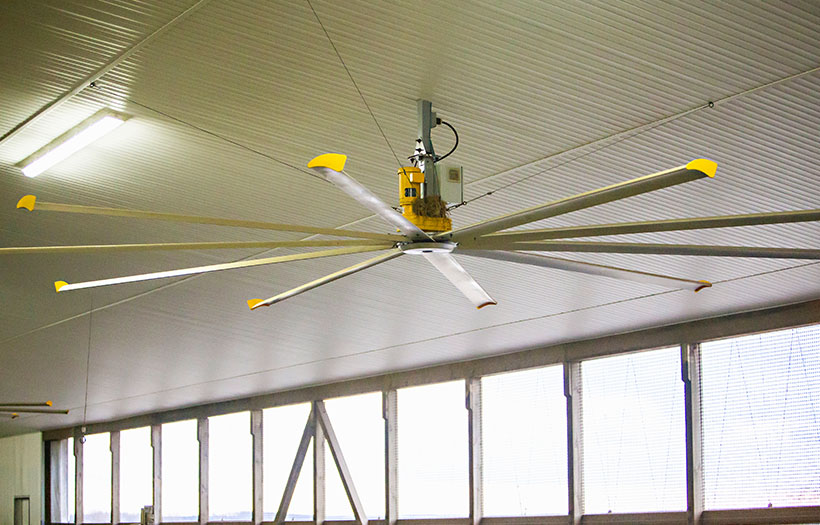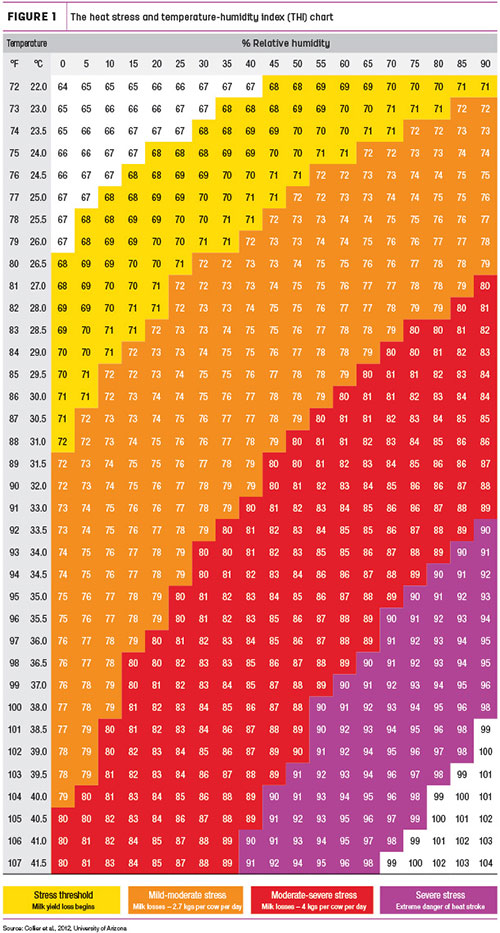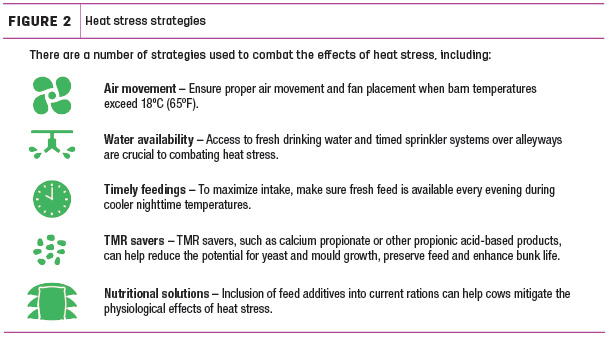Pick Your Battle Against Heat Stress

As we enter the spring and summer months, many of us are thinking of all the fun outdoor activities we will finally be able to do. But while we’re enjoying our barbecues and pools, our livestock may be struggling to cope with the elevated temperatures and humidity.
Heat stress costs the dairy industry millions of dollars annually in losses attributed to decreased performance, increased mortality and decreased reproduction.
Factors contributing to heat stress include air temperature, humidity, wind speed and solar radiation. Cattle experience heat stress when they cannot physically cope with their environmental conditions. Producers know heat stress can have severe impacts on cattle, but what exactly happens to a cow experiencing heat stress?
A progressive problem
While the impact of heat on an animal may seem rapid, heat stress occurs in progressive steps, from mild to extreme. We can quantitatively measure heat stress using the temperature-humidity index (THI) (Figure 1). When THI is higher than 68, cows begin to experience heat stress. A THI of 68 can be as low as 23ºC at 35% humidity.

The effect on milk production
Heat stress at different THI levels will affect cows in a variety of ways. The easiest ones to evaluate are dry matter intake (DMI) and milk production. During heat abatement, cows can reduce their intake as much as 30% to avoid creating more heat from the fermentation of different feed ingredients.
Additionally, rumination will likely drop during heat stress, and this process will result in a lower nutrient absorption efficiency. The result is decreased milk production. By tracking historical milk production, along with on-farm software, a strong correlation between the summer months and lower milk production can be observed.
The need for water is great.
Heat and humidity will increase perspiration as per the heat abatement process. The result: Cows compensate through higher water intake. In turn, more water increases the rate of urination and, with it, the loss of minerals like sodium and potassium – which are essential to buffer rumen pH.
Reproduction impacts
Milk production is not the only key performance indicator on which heat stress can have adverse effects. Conception rate could also drop considerably during heat stress. The drop in conception rate could range from 20% to 60% of its current value.
Heat-stressed cows have reduced production of luteinizing hormone and estradiol (estradiol are the hormones responsible for estrus expression). If a cow is heat-stressed soon after fertilization, development of the embryo can be compromised.
An increase of a mere 0.5ºC in the cow’s uterine temperature can decrease her conception rate by 6.9%. This is also why there is a latent influence of heat stress on fertility. It takes 40 to 60 days after heat stress before undamaged ova are ovulated and fertility returns to normal.
Length of pregnancy can also be negatively affected by heat stress and result in slightly shorter gestation periods. Early parturition would be one of the reasons for putting dry cows on a close-up ration 21 days prior to calving, as it guarantees they are fully prepared for labour.
Heat stress will also have a negative effect on dry cows by decreasing mammary gland development, which is essential for the next lactation. Heat and humidity can also be unfavourable to in utero fetuses, as these future calves born from heat-stressed cows will consequently see an impact on their growth and future milk production.
Hence, a newborn could be up to 12.4% lighter, a weaned calf 10.4% lighter, and future milk production could be decreased by as much as 4 kilograms of milk per day.
Determine the severity
To really measure the impact of heat stress at your dairy, there are several tools you can use. An anemometer to measure wind speed and simple questionnaires to determine heat stress severity can be beneficial. We want to measure wind speed at different places in the barn (e.g., at the robot, in the stalls or at the bunk space) to ensure we are getting a clear and complete picture.
Fortunately, several methods exist to alleviate heat stress in cattle (Figure 2, page 36), starting with the following: shade, air, water and diet.

Shade
Have you ever noticed exterior stalls in your barn get less usage in the summer? Cows will congregate in cooler areas before they will lie in a hot stall. Exterior stalls that take on direct sunlight are simply avoided. If we can better shade those stalls, we could potentially get better stall usage year-round. To maintain the efficiency of milk production and reproduction, shade can provide very positive results on respiratory rate and rectal temperature.
Normal respiratory rate for adult cattle would range from 40 to 60 breaths per minute, and normal body temperature would be around 38.6ºC to 39.2ºC (101.5ºF to 102.5ºF). Thus, shade could come at a low cost for the return on investment in cow health and maximizing barn area. To sum up shade in simple terms: 40 square feet per animal is suggested for cows on pasture.
Air
During hot weather, it is very important to provide at least 60 to 90 air exchanges per hour. It is very important to remove moisture and heat from the facilities. Air speed or velocity increases convective heat transfer and will prevent cattle from gathering under fans or close to a water source.
The addition of high-speed fans in tunnel-ventilated or cross-ventilated barns equipped with baffles can yield improved air movement at the cow level.
Water
Requirements for water consumption will increase as temperature rises, up to 20%. Ensuring water is clean, easily accessible and high-flowing can assist cattle in coping with increased respiration and urination rates. Cooling systems such as sprinklers and misters are part of the solution when it comes to cooling your herd with water.
Sprinklers will use direct evaporative cooling (DEC), a process that consists of soaking the cow’s skin in water intermittently so the heat coming from her body will make the water evaporate from the skin.
Misters use indirect evaporative cooling (IEC). This method uses air to evaporate water, reducing ambient air temperature – thus, helping cows transfer heat from their bodies to the cooler air.
Diet
Last but not least, adjusting feeding regimens in the summer can pay off quickly. Cows tend to eat their largest meals at dusk and at dawn. Work to ensure cows are being fed at one of these times, when the day is typically cooler and cows “feel like” eating.
First, start by checking your dairy’s minerals to be sure they are well balanced before any heat stress.
Next, examine proactive additives that work to cool cows osmotically at the cellular level before heat stress hits.
Employ a reactive strategy to add an additive like calcium propionate to cool feed when it is noticeably hot via physical touch and smell.
Heat stress impacts cows rapidly through a drop in DMI, thus resulting in lower milk production. Yet the effects of summer heat can linger long after cows have been exposed to heat. The ensuing impacts on milk production, reproduction and early embryo development, initiated by heat stress, have the potential to affect not only the current lactation but subsequent lactations and future generations as well.
While there are many ways to reduce heat stress for a relatively low cost, start by scoring your barn to discover your greatest opportunities for cow cooling.
